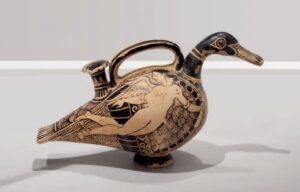
Fasena (askòs) from Volterra
Tomb 224, Trebba Valley
350-300 BC
Woman of Spina, who are you? What was your place in society? Which were your needs? Could modern women understand you? These and more questions were created in our mind, when we saw this vessel in your grave, in a tomb of Trebba Valley, near the ancient city of Spina. This vessel, named faSena, was among other grave goods, which were keeping you company to your afterlife. Your dearests wouldn’t let you be buried without proper honours and ritual practices. In that case, the presence of a faSena, an Etruscan production vessel mainly figurative, which was an important ritual vessel and was generally used for caring oils, but also vinegar or honey, could prove these practices. Now we know that it was destined for your last house. That was the reason of its existence. Lasa, the Etruscan winged goddess-demon, who is depicted on the vessel, would be your carrier to the other side and your protector on this journey.
This was only the spark to understand your place in the ancient city of Spina and in the Etruscan world. Generally, Etruscan women, mainly in the Archaic period from the seventh to fifth century B.C., were in a highly position in comparison to the Greek and Roman women. Their liberty was such a scandal to the Greek and Roman world. Greek and Roman writers give further evidence for these facts, showing how the Etruscan way of life differed from their own, and how this difference frightened them. It became a conflict in civilization, mostly in relations between men and women.
Differences between Etruscan and Greek women were remarkable. Theopompus, the Greek historian of the fourth century B.C., was shocked by Etruscan women activities and arrived at a not totally correct conclusion based on what he saw and heard. He was referring to the nudity of Etruscan women, mostly during exercise with men or that they raised all their children, whether or not they knew who the fathers were, but some of them are presented either more extravagant than it was in reality, or simply false. It was just the freedom of the other sex that was frighten the others. Don’t forget that in ancient Athens women couldn’t even walk outside without the company of a man or another female assistant, the therapenis. They were subjects of a strong patriarchy, without having any right, not even for their lives. The only exception in the Greek world, just a little bit closer to Etruscans’ women place, were the women of Sparta.
In a way, women of Etruria were protagonists in the social structure. Many depictions of the élite at banquets confirm this. Scenes in frescoes with men and women reclining on klinai, consuming wine, socializing equally and reclining next to their chosen partners is one example. The link between pottery for drinking wine and the female world is one of the central topics in Spina graves, where the iconographies of the vases seem to mark themes related to a woman’s world, for instance the gynoecium, abduction and violence.
Did you know that Etruscan women could have individual names, proving their legal and social status, without any reference to a male, father or husband? In contrast, a Roman woman had no name of her own. Their importance is more understandable from art. In sarcophagi, frescos and vessels, mostly in tombs, we could realise their value. Been able to conceive your precious status, you seem the perfect example. An example for modern women nowadays. Thank you fo your existence



